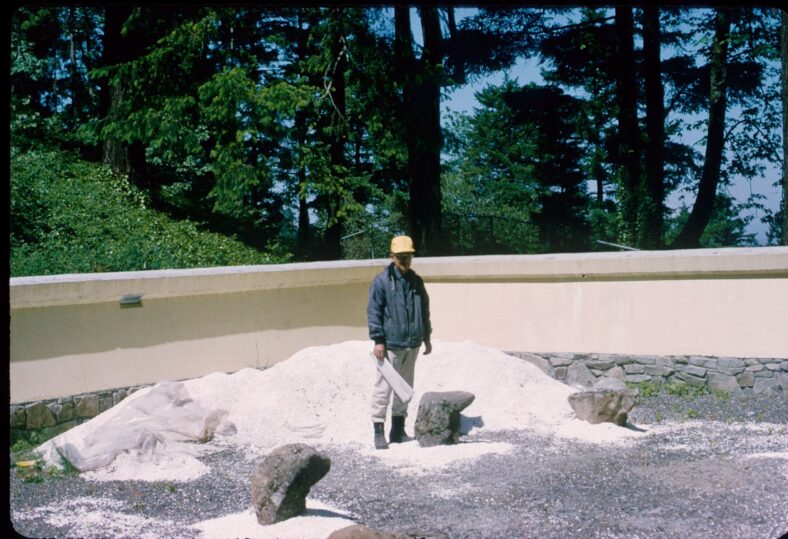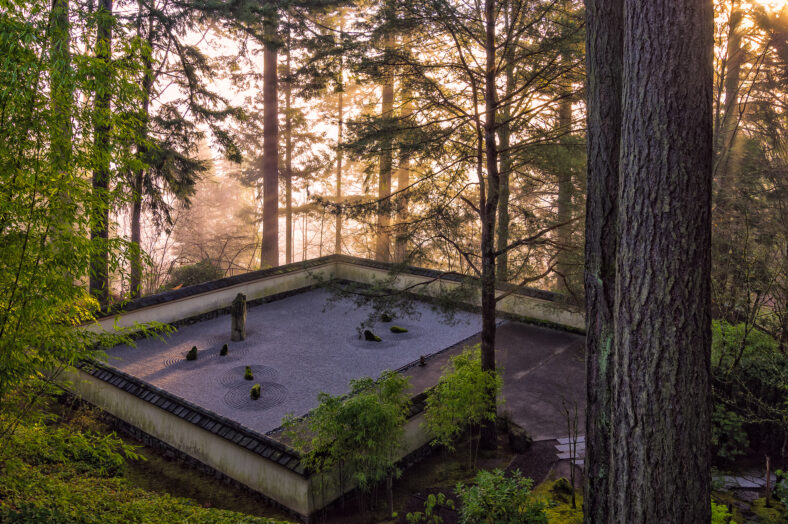
In one of his earliest pieces of correspondence with the initial leaders of Portland Japanese Garden, Professor Takuma Tono, Portland Japanese Garden’s original designer, described the different garden styles he intended to design: the Flat Garden, Strolling Pond Garden, Sand and Stone Garden, and Tea Garden. The fifth garden he designed, a Moss Garden, would be planned later into the process and would eventually be replaced by what is today known as the Natural Garden. Below are Tono’s thoughts.
Note: While Professor Tono did speak and write in English, his busy schedule often prevented him from editing his letters for grammar and spelling. He once wrote, “…you may find some trouble with my words. Please use your nice imagination.” In that spirit, we have edited his writing for clarity.
A Brief Explanation of Portland Japanese Garden by Takuma Tono
Four representative styles are integrated into Portland Japanese Garden to display different kinds of Japanese garden design:
1. Hiraniwa, or, Flat Garden
2. Tsuki-yama or Hill and Pond Garden [Note: Referred to as the Strolling Pond Garden today]
3. Sand and Stone Garden
4. Tea Garden
Hiraniwa – Flat Garden

Entering through the authentic entrance gate* one comes in a Japanese house where Japanese tea is served by Japanese girls dressed in traditional kimonos in Kyoto, Japan’s old capital. To the left, a beautiful view of Mt. Good can be observed from the viewing terrace.
To the right, one finds so-called Hiraniwa, the “Flat Garden.” This is a simple garden, utilizing the open space with little variation, save for the white sand laid flatly on the ground in the shape of a pond. Usually it is a square or an oblong garden fenced off by mud walls or a fence. In addition to the white sand, moss, grass, and trees are used in the most artistic way. A green circle of moss symbolizes “enlightenment” or “perfect character” and a gourd shape means “happiness.”
Evergreen plantings, restricted to tonalities of green, always give secluded quietness and tranquil beauty year-round. Pine, cypress, ilex, yew, and small evergreen plantings like boxwood, daphne, and azalea give the effect of unchangeable beauty.
* Professor Tono originally intended to place the Antique Gate near the Flat Garden and Pavilion. However, a lack of funds delayed the construction of the Pavilion until 1979. Not knowing how much longer it would take to build the Pavilion and not wanting the Antique Gate to go to waste, Garden Director Michio Wakui (1974-76) installed the gate at the foot of what is today known as the Entry Garden in 1976.
Tsukiyama – “Pond Garden”

This type of garden is designed to reproduce the beauty of nature, such as a seascape, in a faithful and realistic way. There are many kinds of these. Some have the pond simulating a wide expanse of shallow water. Some have compositions of stones that produce a pictorial effect reminiscent of a famous place, such as one of the eight famous views of Japan. The outstanding characteristic of this type of garden is to present a picture-like effect and natural beauty characteristic of Japan: curved shorelines and stones in the water that suggest islands. This garden includes a great many trees and shrubs and the pond in it occupies a relatively large space.
Sand and Stone Garden

The “Sand and Stone Garden” is characteristic of an authentic Japanese garden. The rocks are grouped into a balanced, harmonious composition. This has spiritual meaning for the one who sees this garden and feel some identification with it. This type of garden may be worthwhile for people, especially those who usually enjoy a flower garden. They may develop appreciation for another kind of garden without color elements, only sand and stone.
Tea Garden

Tea culture is a refined culture in Japan, because it is always well-mannered and the tea is served with warm friendship. The tea house itself is simple but has the refined taste of shibui [subtle, unobtrusive, and deeply moving beauty]. The tea garden is one attached to a tea room where tea ceremony is held. As such, it has both practical and ornamental purposes. The tea garden includes a line of stepping stones, a water basin, and stone lantern all arranged in an artistic way.
The tea garden is intended to serve a practical purpose, but at the same time, it must be artistic in appearance, with the beauty of nature represented in it. It is instructed that this beauty must be natural enough to make one forget all worry or troubles of this outer world.
A water basin is placed in the inner garden so that guests may wash their hands and rinse their mouth. This is meant to not only only them to clean their body but purify their mind before entering the tea house. Stone lanterns are also arranged to give light in case the tea ceremony is held at night.